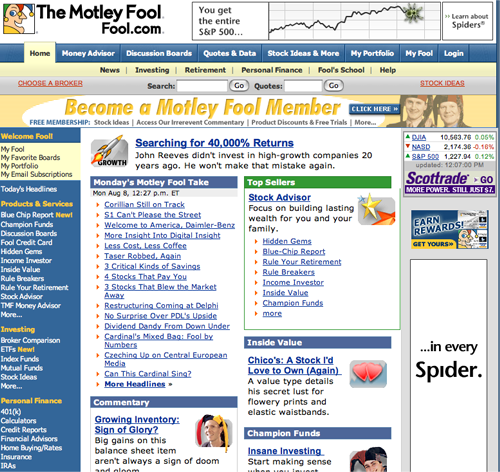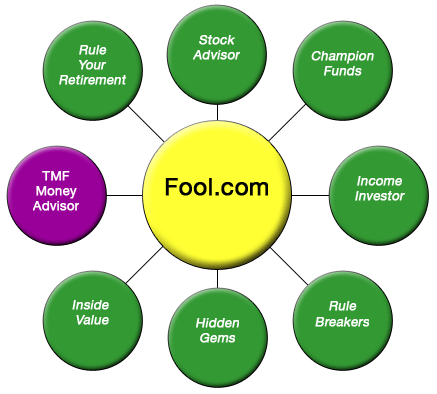The Motley Fool uses its powerful brand to launch seven successful print newsletters for personal investors that will generate $22M in 2005 revenues. Traditional advertising-driven Internet business model takes a back seat.
After the 2001 dot-com stock market crash occurred, The Motley Fool was forced to change its online business model. The years of generating more than $20 million in advertising revenue were long gone, much like the employees who suffered layoffs. They abandoned the advertising model for the print subscription model and today are succeeding handsomely. The Fool’s first print investment newsletter The Motley Fool Stock Advisor (launched as a partnership with Phillips Investment Resources) proved to be very popular and profitable. Its success has now spawned the launch of six more print titles, making The Motley Fool a major player in the paid subscription content business.
- The Motley Fool started as an America Online discussion forum in 1994
- In 1996, the 100 percent advertising-supported www.Fool.com was launched
- In 2001 stock market crash forced them to reconsider online business model
- In 2002, they launched their first print investment newsletter, The Motley Fool Stock Advisor
- In 2003, The Fool launched six additional print titles
- Today, they take advantage of a database of over three million free registered users
- 150,000 of them are active, paid subscribers to its seven investment advisory products, roughly a five percent conversion, generating roughly $22.5 million in gross revenue
- They publish over 700 free articles a month on the website and through email, in attempt of converting free relationships into paid relationships
- Advantage of not spending significant marketing dollars to drive subscriber base
Investing Mystifies Me
Don’t get me wrong, I like making money and I have a lot of investments, but I’m incapable of managing them myself. So for more than 20 years I’ve had a personal financial planner to look after my stock portfolio, manage my 401K and IRAs, and advise me as to what to buy and sell.
For this service, I pay my financial planner a hefty annual fee—nearly one percent of my assets that are under his management. If The Motley Fool had been around when I started investing seriously, I’m not so sure I would have needed all his expensive help. Instead, The Fool would have made me a customer for life.
[text_ad]
The Motley Fool’s founders, brothers David and Tom Gardner, have branded their website with the deft touch of businessmen who know the difference between taking themselves seriously and taking their work seriously.
Here’s an example from Fool.com:
We exist to serve you, to teach you, and to have a heck of a lot of fun along the way. We believe that…
- You are the most capable person alive to manage your money.
- This stuff isn’t rocket science; we all just need to learn together.
- Being smart about your money can be a lot of fun…really!
- You can make a fortune doing it.
With a unique, friendly selling proposition like that, I’m inclined to sign up. No clowning around.
These guys are smart without being stuffed-shirts. They’re confident. They’re natural communicators. They’ve got a unique style.
They entertain their constituency while enlightening them about personal finance and investment.
And they’re not afraid to wear silly court jester hats! It’s all part of The Motley Fool brand, and it succeeds like crazy.
This is definitely not your father’s old staid and stodgy investment advisor.

TheFool.com’s Homepage
The Early Years
The Motley Fool started as an America Online (AOL) discussion forum in 1994. In 1996, Fool.com was launched, which was 100 percent advertising supported to the tune of more than $20 million annually, until the 2001 dot-com stock market crash occurred.
Then The Fool, like many of its competitors, struggled through three rounds of layoffs. It was not fun. That’s when it became clear that a 100 percent advertising business model was not going to enable the company to grow.
So in 2002, The Fool signed a partnership agreement with Phillips Investment Resources, then publishers of 17 or 18 other investment advisory newsletters. Phillips took responsibility for the marketing and publishing of The Fool’s first print investment newsletter, The Motley Fool Stock Advisor.
The content was the creation of David and Tom Gardner, writing about the whole U.S. stock market for well run companies dominating their sectors. They analyzed current risk and opportunities by challenging and debating each other. They still do.
Both Phillips and The Fool marketed the Stock Advisor and together they built the subscriber base quickly and profitably. Fewer than 10 percent of the subscribers were gathered through direct mail; the majority resulted from online efforts.
Previously, The Fool had dabbled with a few subscription products but had never succeeded in doing much with them. But the TMF Stock Advisor proved to be very popular and profitable. So beginning in 2003, The Fool began an aggressive program that resulted in the launch of six additional print titles (see below), without additional help from Phillips.
The Fool now anticipates a product mix of ancillaries including free and paid reports, relationship email, audio conferences, teleseminars, and online courses.
“To compliment the newsletter portfolio we want to build our subscriber base to critical mass,” said Brad Clark, chief marketing officer for The Motley Fool, “and to us that means several hundred thousand people paying an average of $150 or $200 a year. When we can accomplish that, it will give us all sorts of options in terms of things we can do with the subscriber base.”
Currently The Fool has about 150,000 active subscribers to its seven investment advisory products, which are available both in print and online. This number excludes The Fool’s numerous free discussion forum participants and The Motley Fool credit card holders, which provide additional branding opportunities.

This image illustrates the Fool.com Network. Sitting in the center of their product strategy is the free editorial hub, which exists primarily to drive traffic to its paid products. The Fool.com requires registration to access free stock ideas, commentary and free subscriptions. Through this editorial hub, Fool.com steadily builds a giant database through which they market their eight paid products. There are seven print newsletters (represented as retail sites in green) and there is one personal financial tool, the TMF Money Advisor (represented as a membership site in purple).
700 Free Articles Monthly
The Fool.com website gets about four million visits monthly, and has about three million “members,” i.e. visitors who have registered to receive one or more free email publications. Of course, The Fool is working constantly to develop those free relationships into paying customers.
The Motley Fool brand is further reinforced by a weekly radio program heard by several hundred thousand listeners on more than 100 National Public Radio stations. Also, a syndicated news column by David and Tom Gardner appears in 200 newspapers in 43 states and Canada.
Additionally, The Fool does some online direct response marketing, including both pay-per-click search engine advertising and email list rental campaigns. But the content-based emails, which contain articles or article headlines with hypertext links, is the greatest driver of high quality traffic back to The Fool’s website.
Hard numbers for conversion rates from email, pay-per-click, landing pages and order pages is difficult to track (and propriety information). But one macro conversion rate we can calculate is the total number of paid subscribers as a percentage of the total number of email recipients.
Do the math. That’s three million subscribers to free email, divided by 150,000 paid newsletter subscribers—about a five percent conversion rate.
And if those 150,000 subscribers are paying an average of $150 annually for a newsletter, that generates about $22.5 million in gross revenue, which Mr. Clark confirms “is about right.” That’s $22.5 million annually, generated entirely online, almost all in the past two years, and solely through paid investment newsletters.
“The real advantage that we have, unlike a lot of our competitors, is that we don’t need to spend significant marketing dollars to drive our subscriber base, because we have such a large following,” said Mr. Clark. “We are publishing over 700 free articles a month on the website and through email. Our free content engine is a very powerful advantage. We can convert free relationships into paid relationships.”
The Fool also employs a two-step, pay-per-click search engine marketing campaign. It offers a free report in exchange for a name and email address, then follows up to develop that relationship further and introduces its paid services on the back end. The lifetime value of the leads The Fool receives from search engines tends to be higher than leads they receive from other sources, Mr. Clark said.
[text_ad]
More on the Motley Fool Brand
“You could argue that our biggest advantage of all is our editorial voice. People have heard of The Fool, people remember The Fool, and people appreciate our editorial voice. We’ve stayed true to that. And we’ve found because we’re willing to take a point of view, that we have a sense of humor, that we are very approachable—all of those things have really helped us.”
They’re all part of The Motley Fool brand. And that’s no joke.
The Motley Fool Products
|
Subscription Newsletters |
Cost |
| Rule Your Retirement (asset allocation strategies) |
$99
|
| Stock Advisor |
$149
|
| Champion Funds (mutual funds) |
$149
|
| Income Investor (income and growth assets) |
$149
|
| Rule Breakers (growth stocks) |
$199
|
| Hidden Gems (small-cap companies) |
$199
|
| Inside Value (stocks for the long term with a margin of safety) |
$199
|
|
Personal Finance Tool |
|
| TMF Money Advisor |
$199
|
Editor’s Note
Our thanks to Brad Clark for his help with this article. Mr. Clark, chief marketing officer for The Motley Fool, has an economics degree from Harvard University and an MBA from Stanford University. A former management consultant, he co-founded www.military.com that he later sold to Monster.com, before joining The Motley Fool in 2004.


